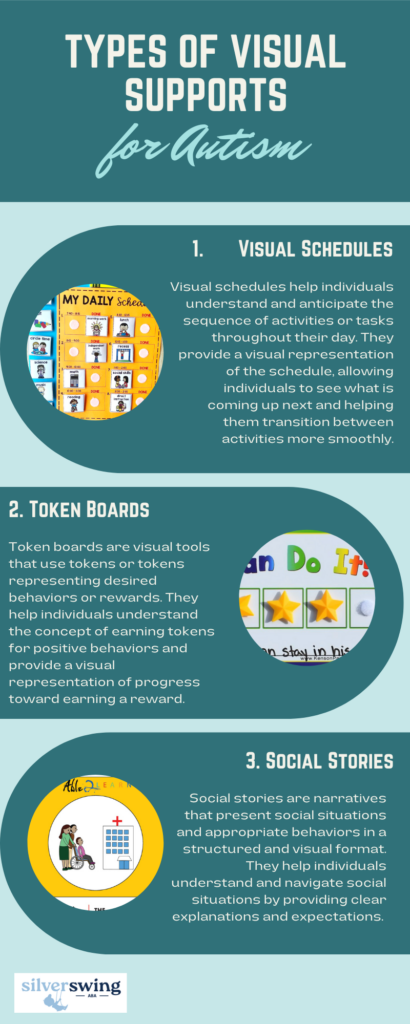Lorem ipsum dolor sit amet, consectetur adipiscing elit. Ut elit tellus, luctus nec ullamcorper mattis, pulvinar dapibus leo.
What is ABA Therapy?
ABA Therapy is a systematic and data-driven approach that aims to understand and modify behavior patterns. It involves breaking down complex skills into smaller, manageable steps and then teaching those steps using various techniques. ABA Therapists work closely with individuals to identify target behaviors and develop strategies to strengthen desired behaviors while reducing challenging ones.
ABA Therapy utilizes a range of strategies and techniques to achieve its goals, including positive reinforcement, prompting, and shaping. Data collection and analysis are integral parts of ABA Therapy, allowing therapists to measure progress and make data-driven decisions to guide treatment.

Visual Supports in ABA Therapy
In the field of Applied Behavior Analysis (ABA) therapy, visual supports play a crucial role in enhancing the effectiveness of therapy sessions. These supports can help individuals with autism and other developmental disorders to better understand and respond to the principles of ABA therapy. I
Visual supports are tools and materials that provide visual cues and aids to support individuals in understanding and following instructions, routines, and expectations. These supports can include visual schedules, social stories, token boards, and more. By using visual support in ABA therapy, information is presented in a clear and structured way, making it easier for individuals to process and respond.
Types of Visual Supports
There are various types of visual supports that are commonly used in ABA therapy. These include:

These are just a few examples of the types of visual supports used in ABA therapy. The selection of visual supports depends on the individual’s needs and goals, as well as the specific principles and strategies employed in their therapy sessions.
Benefits of Visual Supports in ABA Therapy
Visual supports provide a visual framework that promotes understanding, independence, and effective behavior management. Let’s explore some of the key benefits of using visual supports in ABA therapy.
Enhancing Communication
One of the significant advantages of visual supports in ABA therapy is their ability to enhance communication. For individuals with ASD who may struggle with verbal communication or understanding spoken language, visual supports provide a visual representation of information, making it easier to comprehend and express themselves. Visual supports such as visual schedules, choice boards, and social stories can assist individuals in understanding expectations, identifying emotions, and communicating their needs more effectively.

Promoting Independence and Routine
Visual supports also play a vital role in promoting independence and routine within ABA therapy. By providing visual cues and prompts, individuals with ASD can navigate through daily activities and tasks more independently. Visual schedules, for example, can help individuals understand the sequence of activities, reducing anxiety and uncertainty. These supports provide a visual roadmap that allows individuals to anticipate what comes next, enabling them to transition smoothly between activities and develop a sense of structure and routine.
Improving Behavior Management
Another significant benefit of visual supports in ABA therapy is their effectiveness in improving behavior management. Visual supports can be used to establish clear expectations and rules, helping individuals understand what is expected of them in various situations. For instance, token boards can visually represent desired behaviors and rewards, reinforcing positive behavior and motivating individuals to engage in appropriate actions. By using visual supports to clarify expectations, individuals with ASD can better understand behavioral boundaries and work towards achieving positive behavioral outcomes.
The use of visual supports should be tailored to the individual’s needs and preferences, taking into account their unique strengths and challenges. In the next section, we will explore how visual supports are implemented in ABA therapy and provide examples of specific visual supports commonly used.
Implementing Visual Supports in ABA Therapy
This section will outline three key steps to effectively incorporate visual supports in ABA therapy: assessing individual needs, creating visual supports, and using them effectively.
Assessing Individual Needs
Before implementing visual supports in ABA therapy, it is crucial to assess the individual’s unique needs. This assessment helps determine the specific areas where visual supports can be beneficial. A thorough assessment may involve:
- Observation: Observe the individual’s behavior and interactions to identify areas that could benefit from visual supports. This may include difficulties with communication, following instructions, or managing daily routines.
- Communication Assessment: Evaluate the individual’s current communication skills and determine how visual supports can enhance their ability to express needs, wants, and preferences.
- Functional Assessment: Conduct a functional assessment to identify the triggers and functions of challenging behaviors. This information can guide the selection and design of appropriate visual supports to address specific behaviors.
By assessing individual needs, ABA professionals can tailor the visual supports to target specific goals and challenges.

Creating Visual Supports
Once individual needs have been assessed, the next step is to create visual supports that are tailored to the individual’s requirements. Visual supports should be clear, concise, and easily understandable. Consider the following guidelines when creating visual supports:
- Simplicity: Keep visual supports simple and uncluttered to ensure clarity. Use clear images, symbols, or words that are easily recognizable to the individual.
- Consistency: Maintain consistency in the use of visual supports across different settings. This helps the individual generalize skills and promotes understanding.
- Individualization: Adapt visual supports to suit the individual’s preferences and abilities. Consider their age, developmental level, and sensory preferences when designing the supports.
- Accessibility: Ensure that visual supports are easily accessible to the individual. Place them in strategic locations, such as on the wall, in a visual schedule, or on a communication device.
By creating visual supports that are tailored to the individual, ABA professionals can effectively facilitate communication, routine management, and behavior improvement.
Using Visual Supports Effectively
Using visual supports effectively is crucial to maximize their impact in ABA therapy. Consider the following strategies for effective implementation:
- Introduction and Familiarization: Introduce visual supports gradually, allowing the individual to become familiar with them. Provide explanations and demonstrate how to use the supports effectively.
- Consistent Reinforcement: Consistently reinforce the use of visual supports by providing positive feedback and rewards when the individual engages with them appropriately. This helps to reinforce their understanding and encourages continued use.
- Generalization: Encourage the individual to generalize the skills learned through visual supports to different settings and situations. Practice using the supports in various environments to promote generalization and independence.
Using visual supports effectively can enhance communication, promote independence in daily routines, and improve behavior management in ABA therapy.
Implementing visual supports in ABA therapy involves assessing individual needs, creating tailored supports, and using them effectively. By following this systematic approach, ABA professionals can optimize the benefits of visual supports and facilitate progress in communication, routine management, and behavior improvement.
Examples of Visual Supports in ABA Therapy
Visual supports play a crucial role in ABA therapy by providing individuals with clear and accessible information. These supports help individuals understand expectations, routines, and behavior management strategies. Here are some examples of visual supports commonly used in ABA therapy:
Visual Schedules
Visual schedules are visual representations of a sequence of tasks or activities. They provide individuals with a clear visual guide of what is expected of them and help them understand the order of events. Visual schedules can be created using pictures, icons, or written words, depending on the individual’s needs and abilities.
Advantages of Visual Schedules
- Enhance understanding of daily routines
- Reduce anxiety and increase predictability
- Foster independence and task completion
- Encourage flexibility and transitions
Token Boards
Token boards are a form of visual reinforcement system used in ABA therapy. They consist of a visual representation of a desired behavior or task and a set of tokens that can be earned or exchanged for rewards. Token boards provide a tangible way for individuals to track their progress and work towards a specific goal.
Advantages of Token Boards
- Encourage positive behavior and skill acquisition
- Provide a visual representation of progress
- Reinforce desired behaviors through token exchange
- Motivate individuals to work towards a reward
Social Stories
Social stories are visual narratives that describe social events, situations, or concepts in a step-by-step manner. They are designed to help individuals with ASD or other developmental disabilities understand and navigate social situations more effectively. Social stories can include pictures, icons, or written text to convey information.
Advantages of Social Stories
- Improve understanding of social expectations
- Enhance social skills and communication
- Reduce anxiety and challenging behaviors
- Foster empathy and perspective-taking
It’s important to note that the selection of visual supports should be based on the individual’s unique needs and preferences. Collaborating with professionals and utilizing resources available can aid in creating effective visual supports tailored to the individual’s requirements.

Resources for Visual Supports in ABA Therapy
It’s important to have access to the right resources to effectively implement visual supports in ABA therapy. These resources can help parents, caregivers, and ABA professionals further enhance their effectiveness. Here are some valuable resources to consider:
Online Tools and Apps
The digital age has brought forth a wide range of online tools and applications that can be beneficial for ABA therapy. These tools often provide interactive and customizable visual supports that can be tailored to meet the specific needs of individuals undergoing ABA therapy. Some online tools and apps offer features such as visual schedules, token boards, and social stories. These resources can be accessed conveniently from various devices, making them versatile and easily accessible.
When exploring online tools and apps, it’s essential to choose reputable sources that align with evidence-based ABA principles. Collaborating with a qualified ABA professional can help you identify and select reliable online resources that suit your specific requirements.
Printable Visual Supports
Printable visual supports are another valuable resource for ABA therapy. These resources can be easily printed and utilized in various settings, such as homes, schools, or therapy centers. Printable visual supports often include visual schedules, token boards, and social stories, among others.
Numerous websites and platforms offer printable visual supports designed specifically for ABA therapy. These resources can be downloaded and printed for immediate use. It’s important to ensure that the visual supports are clear, visually appealing, and appropriate for the individual’s age and developmental level.
Collaborating with Professionals
Collaboration with professionals in the field of ABA therapy is an invaluable resource for implementing visual supports effectively. ABA professionals, such as behavior analysts or therapists, possess the expertise and knowledge necessary to guide and support individuals undergoing ABA therapy.
Working alongside professionals allows for personalized guidance and recommendations tailored to the specific needs of the individual. ABA professionals can provide insights into the most effective visual supports for different goals and challenges, as well as offer ongoing support and feedback to ensure optimal progress.
Collaboration with professionals also facilitates the exchange of ideas, strategies, and resources within the ABA community. It is through this collaboration that professionals can stay up to date with the latest research, best practices, and advancements in visual supports for ABA therapy.

Tips for Success with Visual Supports in ABA Therapy
There are several key tips that can help maximize their effectiveness and ensure successful outcomes:
Consistency and Reinforcement
Consistency is crucial when using visual supports in ABA therapy. It is important to consistently use the visual supports across different settings and situations to help individuals with autism spectrum disorder (ASD) understand and respond appropriately. This consistency provides a predictable and structured environment, enabling individuals to feel more secure and confident.
Reinforcement is another essential component in ABA therapy. When using visual supports, it is important to reinforce positive behaviors and achievements. This can be done through verbal praise, tokens, or other forms of rewards. By consistently reinforcing desired behaviors, individuals are more likely to engage with the visual supports and understand their purpose.
Individualized Approach
Each individual with ASD is unique, with their own strengths, challenges, and preferences. Therefore, it is important to take an individualized approach when implementing visual supports in ABA therapy. What works well for one individual may not be as effective for another.
To ensure success, it is essential to assess the needs and preferences of each individual. This can be done through careful observation, communication with the individual, and collaboration with parents, caregivers, and other professionals involved in the therapy process. By tailoring the visual supports to the specific needs of the individual, therapy becomes more meaningful and impactful.
Monitoring Progress and Adjusting
Monitoring progress and making adjustments along the way is a vital aspect of ABA therapy. The same applies to the use of visual supports. It is important to regularly evaluate the effectiveness of the visual supports and make any necessary modifications.
Monitoring progress can involve tracking behavioral changes, communication improvements, and overall engagement with the visual supports. This information can help identify areas of success and areas that may require adjustments. By continuously assessing and adjusting the visual supports, therapy can be fine-tuned to meet the evolving needs of the individual.
Through consistency, an individualized approach, and ongoing monitoring and adjustments, visual supports can become powerful tools for enhancing communication, promoting independence, and improving behavior management in individuals with ASD.
Sources:
- https://www.autism.org.uk/advice-and-guidance/topics/communication/communication-tools/visual-supports
- https://ncse.ie/wp-content/uploads/2021/06/Using-Visuals-to-Support-Communication.pdf
- https://cdd.health.unm.edu/autismportal/wp-content/uploads/2019/10/Visual-Supports-for-Children-with-ASD.pdf
- https://www.readingrockets.org/topics/autism-spectrum-disorder/articles/visual-supports-students-asd




